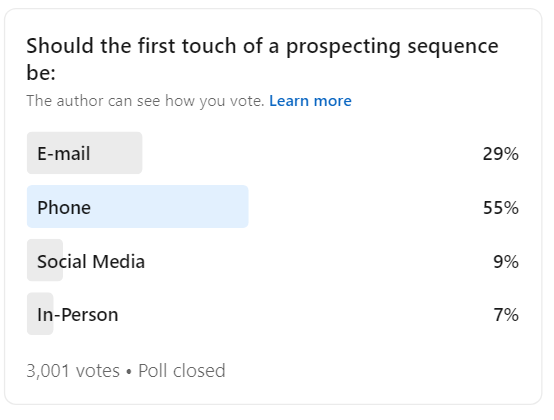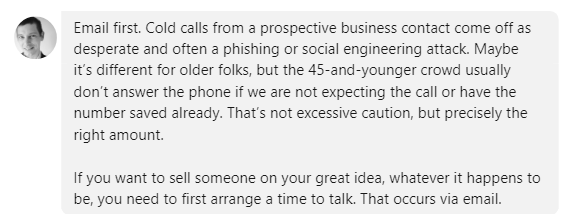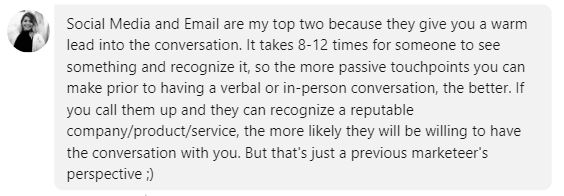Salespeople are being taught to fear cold calling by people who should know better. Much of the advice they offer validates and even spreads a fear of sales interactions. There is never a reason to fear calling a stranger, especially since every won deal starts by meeting a stranger.
Without meaning to, my friend Jeb Blount created quite a clamour on LinkedIn. The poll he posted asked which medium to use first in a prospecting sequence: phone, email, social media, or an in-person visit. He argued (and I agree) that the phone should start your sequence. The reason is simple and straightforward: if the person who answers your call agrees to a meeting, you no longer need a sequence.

The comments on Jeb’s poll were both revealing and incredibly disappointing. Cold calling has consistently been a lightning rod on social media, with a few salespeople advocating for an “all of the above” approach, including the telephone. But I want to set aside that debate for a few minutes, because the comments highlighted a much larger potential threat: fear of sales.




The Mass Infection of Fear
One vocal opponent of cold calling, an entrepreneur, commented on Jeb’s thread that his approach was to buy ads on Facebook, providing a link that a prospective client might click on. Only after the prospect clicked the link did this person believe he could reach out them. The problems with this approach would overflow a week’s worth of posts, so in the interests of time I’ll just note a couple. First, one-to-many messaging is marketing, not sales. Second, no individual salesperson has a Facebook pixel and a budget to run ads. Relying on Facebook ads may be the right choice for entrepreneurs but its awful advice for a salesperson. What’s underneath that advice, however, is worse: the entrepreneur was too afraid to call his prospective clients.
Other comments suggested that one must warm up the prospective client by sending them an email, claiming that it is important for the client to see your name on an email before they get your call. To be honest, I’m having trouble following that logic. How exactly does getting a cold email create the desire to speak to the person who sent it? Unless you spend your day starting at your phone, hoping against hope that the people who just spammed you will call you to spam you again, then you cannot possibly believe that an email makes it safer to dial a prospect’s number. And there’s the rub: when email-first salespeople talk about safety, they broadcast the same fear of calling a stranger. An odd thing, that, given that every good thing that ever happens to you in sales is the result of meeting a stranger.
Finally, one person suggested that the best way to start a prospecting sequence is with a warm referral. His response gave a very long explanation of how to respond to an introduction over email or on LinkedIn, again emphasizing the asynchronous communication tools that so many salespeople hide behind. The same people who are afraid of calling a stranger are also reluctant to call up their clients and ask for a referral. They worry about imposing on their client, so they avoid asking for the referral in a real conversation and instead defer it to email.
With all this fear floating around, here’s a reminder: no salesperson has ever been scarred for life by making a cold call, although many have experienced incredibly negative consequences because they didn’t create enough opportunities.
The Long-term Harm of Fearing Your Clients
There are deleterious effects of teaching salespeople to fear their prospective clients. If a ten-minute phone conversation is so dangerous, then I can only imagine how much the salesperson should fear advising the client on what they need to do to improve their results. And just imagine those poor salespeople working on big deals, with multi-year, multi-million dollar payoffs, the kind that require the salesperson to negotiate with the client, or worse, their purchasing department. Terrifying, I tell you. Just terrifying.
This fear-based approach goes hand in hand with the idea that marketing is responsible for creating sales opportunities and that sales appointments should be handled by crude robots. Conflict aversion is harmful to the development of a salesperson, simply because embracing conflict is the only way to make a positive difference for your clients. No one is ever going to find a compliant, conflict-averse, namby-pamby, order-taker to be consultative, nor will they ever find them to be a trusted advisor.
What makes one a trusted advisor is their willingness to tell the truth at any price, even the price of the deal. The need to be liked is not the same as being likable. The first is detrimental, the other is an advantage. But the advantage of being likable is not available to one who fears their client, especially when it prevents them from having the necessary conversations around change.
A New Hope
In my view, the new hope is the SDR. While salespeople in this category are rarely deployed as effectively as they should be, at least they aren’t being infected with the result-crushing belief that they should fear making a phone call: cold, hot, or indifferent. Their willingness to keep making cold calls will help them develop crucial character traits for sales effectiveness: comfort with conflict, understanding how to trade value for time, unafraid of proposing next steps, able to handle objections, and unaffected by what others would call rejection.
For a long time now, I have been telling sales leaders to prioritize the development of their sales force. Those who take this advice are doing well. Those who don’t often arrest their salespeople’s development, whether it’s by giving into fear or falling for other get-out-of-work-free promises by faux-experts—few of which even consider the long-term effects of their decisions or recommendations.
Do Good Work:
- Look for advice that serves your results.
- Avoid people who would infect you with their fears.
- Never be afraid of calling anyone when you believe you may be able to help them—even if they reject or ignore you.





























